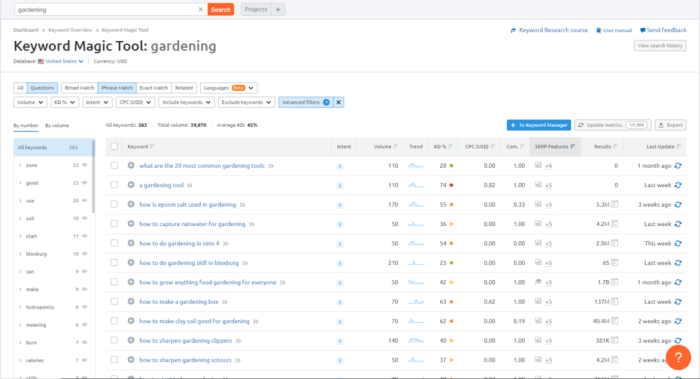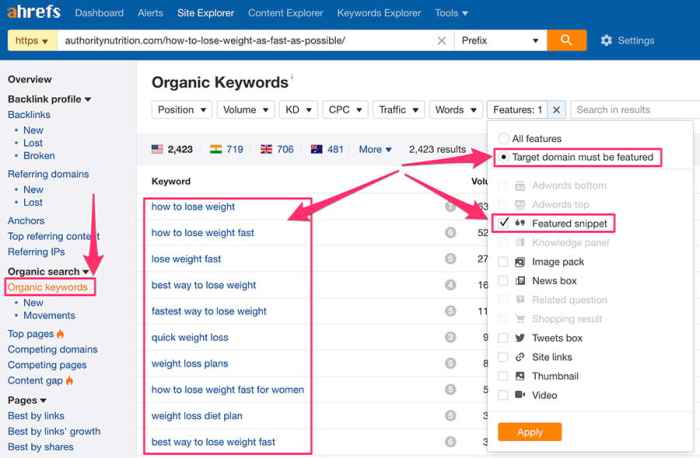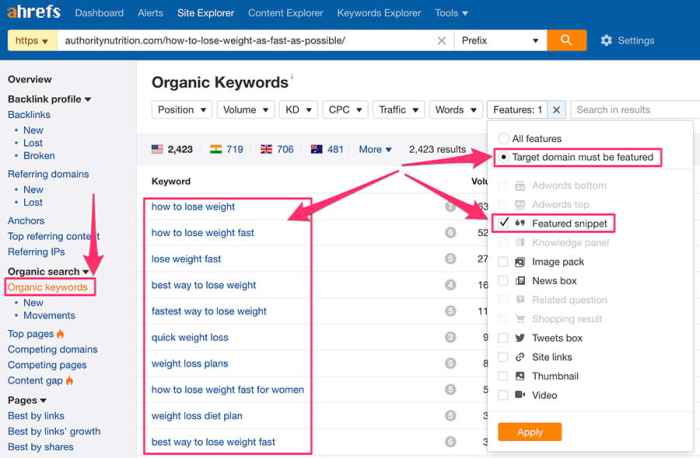Rank Google Featured Snippets: Unlocking the secrets to dominating search results. This comprehensive guide delves into the world of featured snippets, explaining how to optimize your content for higher visibility and increased organic traffic. We’ll explore the different types of snippets, the crucial content structure, and how to analyze search queries for maximum impact. Learn the strategies and tactics to elevate your website’s ranking and achieve coveted featured snippet placement.
Understanding Google’s featured snippets is key to understanding how search results are presented. From concise paragraphs to detailed lists and tables, featured snippets are the highlight of a search, providing quick answers and often driving direct traffic to the source. This guide offers practical advice and actionable steps to improve your site’s chances of capturing these valuable spots.
Understanding Featured Snippets
Featured snippets are highly coveted spots on Google search results pages. They’re concise summaries of answers to user queries, often appearing prominently above the organic search results. This prime placement makes them a valuable tool for both searchers and website owners. Understanding how they work can significantly impact a website’s visibility and organic search ranking.These snippets provide quick answers directly within the search results, saving users the time of clicking through to a full webpage.
They can take various forms, from simple paragraphs to more complex lists and tables, all designed to give a clear and concise response to the user’s search query.
Appearance and Placement on Search Results Pages
Featured snippets are typically displayed prominently at the top of the search results page, above the standard organic search listings. Their appearance often varies slightly depending on the specific query and the type of snippet. They are visually distinct from the other search results, often with a different background color or a slightly different font style. This prominent placement signals to users that the information is a direct answer to their query.
Different Types of Featured Snippets
Featured snippets come in various formats to best address different user needs.
- Paragraph Snippets: These are the most common type, presenting a concise answer in a paragraph format. They’re ideal for questions that can be answered in a short, straightforward manner.
- List Snippets: These snippets present information in an ordered or unordered list format. This is particularly useful for queries requiring a series of steps, a collection of items, or a list of options.
- Table Snippets: For queries involving data comparison or structured information, table snippets provide a tabular format. This format is useful for displaying comparisons, classifications, or specific details in a structured way.
Factors Influencing Eligibility for a Featured Snippet
Several factors contribute to a page’s eligibility for a Featured Snippet. These include the quality and relevance of the content, the structure of the page, and the overall authority of the website. Google’s algorithms assess numerous signals to determine if a page’s content accurately and comprehensively answers the user’s query. Clear, concise answers, well-structured information, and relevant s are all important considerations.
Want to crack the code on ranking for Google featured snippets? A key part of that is understanding user intent. You need to craft compelling copy that directly answers the searcher’s question. Tools like the so what copy test can help you analyze your content and identify areas for improvement. Ultimately, mastering this kind of copywriting is crucial for securing those coveted featured snippet spots.
Impact on Organic Search Visibility
Featured snippets can significantly boost organic search visibility. By appearing at the top of the search results, they attract immediate attention and can drive more traffic to the associated webpage. A higher click-through rate to the page from the snippet can also contribute to better search ranking overall.
Table of Featured Snippet Types
| Type | Example | Typical Length |
|---|---|---|
| Paragraph | What is the capital of France? | 1-3 sentences |
| List | Top 5 programming languages | 3-5 items |
| Table | Comparison of different car models | 2-3 rows, 2-3 columns |
Optimizing for Featured Snippets
Featured snippets are a powerful way to improve your website’s visibility and drive traffic. They’re essentially concise answers to user queries, displayed prominently at the top of Google search results. Optimizing your content for featured snippets can significantly boost your organic search rankings and establish your website as a trusted source of information.Understanding the strategies and techniques for crafting content tailored to these coveted positions is key to achieving a prominent place in search results.
This involves more than just stuffing; it demands a deep understanding of user intent, providing clear and concise answers, and adhering to the structured format Google prioritizes.
Strategies for Content Creation, Rank google featured snippets
Creating content optimized for featured snippets requires a thoughtful approach. It’s not enough to simply address a search query; you need to anticipate the user’s need and provide a complete, accurate, and concise response. Focus on answering the question directly and comprehensively within the first few sentences of your content. This upfront clarity helps Google quickly identify your content as a suitable answer.
Importance of Clear, Concise, and Accurate Information
Featured snippets are all about delivering the most relevant and accurate information to users quickly. Clear and concise language is crucial; avoid jargon and overly complex sentences. Accuracy is paramount. Inaccurate information will not only hurt your rankings but also damage your credibility. Ensure your facts are correct and up-to-date, and cite reliable sources where necessary.
This reinforces your authority and trust with search engines.
Role of Structured Data Markup
Structured data markup helps Google understand the content of your page. By adding schema markup to your HTML, you essentially provide a structured “recipe” for your content, telling Google exactly what each piece of information represents. This explicit communication improves the chances of your content being selected as a featured snippet. Tools like Google’s Structured Data Testing Tool are invaluable in ensuring your markup is correctly implemented.
Content Structure for Different Snippet Types
Featured snippets come in various formats, including paragraphs, lists, tables, and even code snippets. Understanding these different types is essential for tailoring your content effectively. For example, if a query requires a step-by-step process, a numbered list is appropriate. If the query seeks comparative data, a table might be the best choice.
Table: Content Formats for Featured Snippet Types
| Featured Snippet Type | Content Format | Example Query |
|---|---|---|
| Paragraph | Concise, comprehensive answer in a single paragraph. | “What is the capital of France?” |
| List | Ordered or unordered list of items. | “What are the benefits of exercise?” |
| Table | Tabular data for comparisons or multiple pieces of information. | “What are the differences between iOS and Android?” |
| Code Snippet | Code examples, syntax, or programming instructions. | “How to create a simple HTML page?” |
Content Structure for Featured Snippets
Crafting content optimized for Google’s featured snippets requires a strategic approach beyond simply answering questions. It involves structuring information in a way that Google’s algorithms can easily parse and present to users. This structured approach allows for concise, accurate, and highly visible responses to search queries.Understanding the underlying logic of featured snippets, recognizing the importance of clarity and conciseness, and mastering the various structural elements are key to achieving high rankings.
This section delves into the specific content structures needed for successful featured snippet optimization.
Question-Based Snippet Structure
Crafting compelling answers to user queries is crucial for featured snippets. Instead of directly answering a question, present the answer in a clear, concise, and structured format. The focus should be on delivering the most accurate and comprehensive information within the allocated space.For example, if the query is “What are the benefits of exercise?”, rather than just listing benefits, structure the answer with clear headings and bullet points, each point elaborating on a specific benefit.
Concise and Accurate Answers
Creating concise and accurate answers requires careful consideration of the target audience and the specific question. The goal is to provide the most relevant information within the snippet’s character limit. Avoid unnecessary jargon or overly complex explanations.Example: Instead of a lengthy explanation, provide a succinct definition followed by a brief, bulleted list of key characteristics. If a complex formula is involved, use a clear and simple explanation, followed by the formula.
Incorporating Structured Data Formats
Leveraging structured data formats enhances the readability and understandability of the snippet. Lists, tables, and other structured data formats provide a clear, organized presentation of information.
- Lists: Use numbered or bulleted lists to present steps, characteristics, or key points. Each item in the list should be concise and relevant.
- Tables: Use tables to present data in a comparative or tabular format. Ensure clear and descriptive column headers. Example: Comparing different types of exercise by intensity and benefit.
- Definitions: Include clear and concise definitions of terms or concepts, especially if they are specific to the subject matter.
Presenting Information Clearly and Concisely
Clarity and conciseness are paramount for featured snippets. Information must be presented in a way that is easily digestible and comprehensible to users. Use clear and simple language, avoiding technical terms unless absolutely necessary.Example: Use short, impactful sentences. Break down complex ideas into smaller, more manageable chunks. Employ headings and subheadings to organize information.
Content Structure Table
This table Artikels various content structures suitable for different featured snippet types.
| Snippet Type | Content Structure | Example |
|---|---|---|
| Definition | Clear definition, followed by a concise explanation. | “What is photosynthesis?” |
| List | Numbered or bulleted list of key points. | “Steps to solve a quadratic equation.” |
| Table | Comparative table showcasing key data. | “Comparison of different types of running shoes.” |
| Step-by-step guide | Sequential steps, with visual cues where appropriate. | “How to bake a cake.” |
Analyzing Search Queries and Trends

Understanding search queries and trends is crucial for effective Featured Snippet optimization. This involves delving into the specific language and phrasing people use when searching for information on a particular topic. By analyzing these queries, we can identify the types of content Google deems most helpful and relevant, ultimately shaping our content strategy for maximum visibility.Understanding the relationship between search queries and Featured Snippets is paramount.
Google’s algorithm prioritizes content that directly answers user queries. A well-structured answer, aligned with the specific language of the search, significantly increases the likelihood of earning a Featured Snippet.
Want to boost your Google ranking? Optimizing for featured snippets is key. A crucial part of this is understanding how people consume information online, including visually rich content like social media photos and videos. Learning how to use social media photos videos effectively can greatly influence your SEO strategy. High-quality, engaging visuals can significantly improve your site’s visibility in search results, ultimately leading to better featured snippet placement.
Relationship Between Search Queries and Featured Snippets
Featured Snippets are essentially concise answers to common search queries. They are designed to provide users with quick and relevant information directly within the search results page, reducing the need to click through to other pages. Therefore, understanding the specific language used in search queries is critical for creating content that resonates with Google’s algorithm and aligns with user intent.
Identifying Prevalent Search Queries
A range of tools and techniques can help identify the most prevalent search queries related to a specific topic. These include Google Trends, Google Planner, Ahrefs, and SEMrush. These tools provide data on search volume, trends, and related s. By analyzing this data, we can uncover the specific phrasing people use when searching for information.
Determining Content Types Prioritized in Featured Snippets
Google prioritizes content that provides concise, accurate, and comprehensive answers to specific queries. This often includes:
- Definition-based snippets: These concisely explain terms or concepts, providing quick definitions. For instance, a search for “what is artificial intelligence” might yield a Featured Snippet that provides a succinct definition of AI.
- How-to guides: Clear and step-by-step instructions are highly valued. A search for “how to bake a cake” often results in a Featured Snippet outlining the baking process.
- Comparison articles: Featured Snippets frequently feature comparative analysis of products, services, or ideas. A search for “best running shoes” could yield a Featured Snippet that compares various shoe models based on different criteria.
- List-based content: Concise lists of items, tips, or steps often perform well in Featured Snippets. For example, a search for “benefits of exercise” could be answered with a Featured Snippet presenting a bulleted list of health advantages.
Tracking Changes in Search Queries and Trends
Continuous monitoring of search queries and trends is essential for staying ahead of the curve. This allows for proactive adjustments to content strategy based on shifts in user demand.
Figuring out how to rank for Google featured snippets is a tricky game, but understanding the quality of links you’re building is key. A crucial element in this process is knowing how to assess if a link is genuinely beneficial or detrimental to your site’s authority. For example, learning to identify good vs. bad links can significantly impact your overall ranking potential.
This involves careful evaluation of the linking site’s reputation and the context of the link within the surrounding content, as detailed in this guide on how to determine if a link is good or bad. Ultimately, focusing on high-quality backlinks will help you improve your chances of snagging those coveted featured snippets.
- Regular monitoring of Google Trends: This tool allows you to track the popularity of specific search queries over time, highlighting emerging trends and declining interests.
- research tools: Regularly reviewing research tools can reveal shifts in search volume and related s. This enables adjustments to the content’s focus.
- Analyzing search result variations: Google’s search results can be dynamic. By analyzing the variations in search results over time, you can adapt to the evolving needs of searchers.
Refining Content for Featured Snippet Optimization
Using search query data to refine content for Featured Snippet optimization is a key component of the process.
- Incorporate s: Use the identified s and phrases naturally within the content, ensuring it accurately addresses user queries.
- Optimize content structure: Structure the content in a way that clearly and concisely answers the search query. This could include bullet points, numbered lists, or tables.
- Ensure accuracy and comprehensiveness: Providing accurate and comprehensive information is essential. This will demonstrate value and trustworthiness to Google’s algorithm.
Performance Measurement and Evaluation
Tracking the success of your featured snippet optimization efforts requires a robust methodology for monitoring performance and evaluating impact. This involves understanding how well your optimized content is performing in search results and measuring the resulting changes in website traffic. Careful monitoring allows for adjustments to strategies, ensuring continued improvement.A key aspect of this process is understanding the relationship between optimization efforts and quantifiable results.
Effective performance measurement involves selecting relevant metrics, collecting data, and analyzing trends to determine the effectiveness of your chosen approach. This enables you to identify areas for improvement and refine your strategies for achieving better results in the future.
Methodology for Tracking Optimized Content Performance
A comprehensive methodology for tracking optimized content performance begins with establishing clear goals and defining specific metrics for success. This includes setting benchmarks for organic traffic, click-through rates, and time on page. These benchmarks should be aligned with the overall business objectives. Regular monitoring of these metrics is crucial to identify patterns and trends. Tools like Google Analytics provide valuable insights into website traffic, user behavior, and conversion rates, offering essential data for evaluating optimization efforts.
Monitoring Page Visibility in Search Results
Monitoring the visibility of a page in search results is essential for assessing the impact of optimization efforts. This involves regularly checking the ranking of your target s in search engine results pages (SERPs). Tools like SEMrush and Ahrefs can provide detailed information about rankings, search volume, and competitor analysis. Consistent monitoring allows for the identification of changes in rankings and the impact of these changes on overall website traffic.
Measuring the Impact of Featured Snippets on Website Traffic
The impact of featured snippets on website traffic can be measured by tracking the increase in organic traffic, particularly from users searching for the s targeted by the snippet. Tools like Google Analytics can be used to monitor specific traffic sources and track the referral patterns of users who click on featured snippets. This allows for the identification of s that are driving traffic and the evaluation of the performance of the optimized content.
Measuring the Effectiveness of Content Optimization Strategies
Evaluating the effectiveness of content optimization strategies requires a multi-faceted approach, considering various metrics and factors. This includes analyzing the click-through rates (CTR) from search results, the time users spend on the page, and the bounce rate. These factors provide valuable insights into user engagement and the overall effectiveness of the optimized content. A/B testing different content variations can further refine optimization strategies.
Metrics for Evaluating Featured Snippet Optimization
| Metric | Description | How to Measure |
|---|---|---|
| Organic Traffic (from Featured Snippets) | Number of visitors coming from search results that include a featured snippet for the target . | Use Google Analytics to filter traffic by source and . |
| Click-Through Rate (CTR) | Percentage of users who click on your link from the search results, including featured snippets. | Use Google Search Console or a third-party tool. |
| Average Time on Page | Average duration users spend on the page after clicking from the featured snippet. | Google Analytics. |
| Bounce Rate | Percentage of users who leave the page after viewing a single page. | Google Analytics. |
| Ranking (for target s) | Position of your page in search results for targeted s. | Use tools like SEMrush or Ahrefs. |
Examples of Effective Featured Snippets
Featured snippets are highly coveted real estate on Google’s search results page. They’re concise answers directly displayed beneath the search results, often answering user queries quickly and efficiently. Understanding the types of snippets and how they’re structured is crucial for crafting content that earns this prime placement. This section dives into practical examples to illustrate effective strategies for optimizing your content for featured snippets.Effective featured snippets aren’t just about stuffing; they’re about providing valuable, concise answers to common user queries.
The structure and content must precisely align with the user’s intent, providing a complete and accurate response in a clear, structured format. This approach fosters a positive user experience and signals high-quality content to Google’s algorithm.
Different Types of Featured Snippets
Various types of featured snippets cater to different search queries. Understanding these types allows you to tailor your content to match the expected format.
- Paragraph Snippets: These are the most common type. They directly answer a question with a short, concise paragraph. The content should be focused and factual, avoiding unnecessary fluff. For example, a search query like “What is the capital of France?” would likely result in a paragraph snippet. The answer should be clear and accurate, like “The capital of France is Paris.”
- List Snippets: These snippets present information in a bulleted or numbered list format. They’re excellent for providing step-by-step instructions, defining key characteristics, or presenting a series of related items. A search query like “How to bake a cake” might result in a list snippet, outlining the baking steps. A search query like “Benefits of exercise” might present a list of health benefits.
- Table Snippets: These snippets use tables to present structured data. They’re ideal for comparing products, displaying statistics, or showing different values for various parameters. A search query like “Comparison of different types of running shoes” might generate a table snippet showcasing features and pricing for different models.
- Code Snippets: These are less common, but can be extremely useful. They display code examples directly in the snippet, useful for programming-related searches. A search query like “Python code for calculating the area of a circle” would potentially generate a code snippet showcasing the Python code.
Illustrative Examples of Effective Featured Snippets
This table showcases different types of featured snippets, along with the corresponding search queries and optimized content excerpts. It highlights the importance of structure and conciseness in achieving featured snippet placement.
| Query | Snippet | Optimized Content Excerpt |
|---|---|---|
| What are the benefits of yoga? | Yoga offers physical and mental well-being, improving flexibility, balance, and reducing stress. | Yoga’s benefits extend beyond physical flexibility. It promotes balance, reduces stress, and contributes to overall well-being. Studies show yoga can improve mental clarity and emotional regulation. |
| How to boil an egg? | To boil an egg perfectly, follow these steps: Place the egg in a pot, add cold water, bring to a rolling boil, and then simmer for 6-8 minutes. | |
| Comparison of different types of running shoes | | Feature | Running Shoe A | Running Shoe B ||—|—|—|| Cushioning | High | Medium || Weight | Light | Medium || Price | $150 | $100 | | This table compares two popular running shoe models. Running Shoe A offers superior cushioning but comes with a higher price tag. Running Shoe B provides a balance of cushioning and weight, at a more affordable price. |
Outcome Summary: Rank Google Featured Snippets

In conclusion, achieving featured snippet placement is a multifaceted process requiring a deep understanding of user intent, content structure, and data analysis. By following the strategies Artikeld in this guide, you’ll be well-equipped to craft content that not only ranks high but also directly addresses user queries, driving targeted traffic and boosting your site’s authority. Your journey to ranking Google featured snippets starts now!








